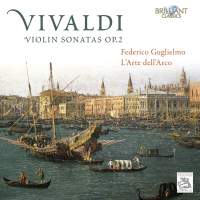Texte paru dans: / Appeared in: |
|
|
Outil de traduction ~ (Très approximatif) |
|
|
Reviewer: Robert
Maxham It’s clear from the first rushing figures of the Preludio of Vivaldi’s relatively popular Sonata, op. 2/2, in A Major, RV 31, and the jaunty Corrente that follows it, that Federico Guglielmo and members of L’Arte dell’Arco have imbued Brilliant’s complete recording of the master’s first-published set of solo violin sonatas with a beauty of tone, lusty vigor, and sly wit that justify the composer’s own fondness for the works. The ensemble varies the continuo’s instrumentation, with Francesco Galligioni playing cello, Roberto Loreggian including both harpsichord and chamber organ, Michele Pasotti playing both theorbo and Baroque guitar and base their performance on Critical Edition published by the Istituto Italiano Antonio Vivaldi, of which Brilliant claims their recording to be the very first. The ensemble tune their instruments to A = 440 Hz, modern concert pitch, of course, but coincidentally, the prevailing pitch in Vivaldi’s Venice. They combine archness and seriousness in the Preludio of the Sonata in D Minor, op. 2/3, that follows (they take the works out of order). Their performance of the Corrente and the Gigue make clear these works’ melodic and harmonic indebtedness to Corelli’s solo sonatas. The Allemanda of the Sonata in F Major, op. 2/4, makes a perhaps even more direct reference to works by the earlier master; the ensemble churns the continuo part underneath Guglielmo’s buoyant solo. Guglielmo adds (or seems to add) flowing ornamentation to the following Sarabanda, intensely patterned in its sequential passages. Guglielmo mentions in his booklet notes the contrapuntal nature of many of the movements, and the opening movement of the C-Major Sixth Sonata, RV 1, if it doesn’t push the envelope of complexity, nevertheless allows him and the continuo players to engage in intimate thematic, or at least motivic, dialogue. As throughout the works, Guglielmo plays the briskest movements (in this case, an Allemanda) crisply without lifting his bow off the strings or digging aggressively into them. He underlines the connections of the Giga with Corelli’s versions of the same dance and spikes its passages with exuberant roulades. In the First Sonata, in G Minor, RV 27, both the Preludio and the Giga that follows it sound in this reading as though listeners have heard them in works of the older master (in fact, Guglielmo remarks that they represent a stylistic synthesis of Corelli’s sonatas and the earlier Venetian tradition). The ensemble walks doggedly beneath the Sarabanda; the Corrente, for once, sounds relatively sedate compared to the set’s other similarly designated movements. The 11th Sonata, in D Major, RV 9, appears as a duo for violin and cello (Guglielmo cites one of the editions’ title page suggesting this combination as a possible one, yet he cautions that although he has followed its suggestion because of the imitation between the two parts, that suggestion may be simply a convention). The melodic conversation of the first movement continues in the second with exchanges largely giving way to heady rhythms that dissolve in the third into a more simply accompanied melody. The second disc opens with a piquant reading of the Preludio of the Eighth Sonata, in G Major, RV 23. Guglielmo’s exuberance in the Giga doesn’t disguise its connection with Corelli’s similar works, although it’s hard to believe that the violinist would have wanted—or been capable of—any kind of camouflage. He colors the finale, a Corrente, with pizzicato versions of the theme. Soloist and ensemble begin the Ninth Sonata, in E minor, RV 16, more darkly—both timbrally and stylistically; but they bring nearly ideal fancy to the Capriccio, suave elegance to the Giga, and a starchy strut to the Gavotta. The continuo displays imaginative timbral sensitivity to its passage before the solo entry in Preludio of the 12th Sonata, in A Major, RV 32; and Guglielmo should move even the most unsympathetic listener with its pathos. The first movement of the Sonata in C Minor, op. 2/8, RV 8, features exchanges between the violin and cello that point to the kind of dialogues that later composers would make a staple of their chamber styles. Guglielmo sounds pointed at the beginning of the F-Minor 10th Sonata’s Preludio but allows the movement to flow more tranquilly to its conclusion. The Allemande sounds almost jazzy in his reading. The collection ends with the Sonata in B Minor, op. 2/5, RV 36, featuring a vigorous performance of its central Corrente and a bracing one of its Giga finale. The engineers have provided recorded sound of great warmth and clarity, with the solo violin appearing generally at the small ensemble’s fore. Listening enthusiastically to this set, it’s hard to go back to the opulent one that Salvatore Accardo made for Philips: The improvisational energy, though held within bounds, still permeates the atmosphere of Guglielmo’s interpretive universe. The change, accomplished in only a few decades, gives rise to serious reflection: Within my lifetime, collectors have been able to hear the first recording of The Four Seasons by Louis Kaufman and follow ripe ensembles, desiccated experimental-sounding later ones, and neo-triumphalist revivals until a magnificent and convincing synthesis has emerged in recent recordings of the composer’s works—of which Guglielmo provides a choice example. Nobody—composer or publisher—may have intended that these sonatas be heard seriatim, but they can be, without any fatigue at all. Urgently recommended as one of the most exciting, sensitive, and overall engaging performances of Vivaldi’s works in any genre in my several decades at Fanfare. | |
|
|
|
|
Cliquez l'un ou l'autre
bouton pour découvrir bien d'autres critiques de CD |
|




